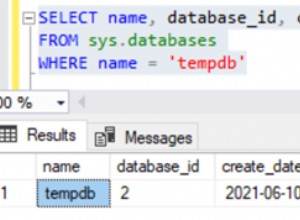Dato che sei su SQL Server 2012... ecco una versione che lo usa. Potrebbe essere più veloce di altre soluzioni, ma devi testarlo sui tuoi dati.
sum() over() farà una somma corrente ordinata per Id aggiungendo 1 quando è presente un valore nella colonna e mantenendo il valore corrente per null valori. La somma corrente calcolata viene quindi utilizzata per partizionare il risultato in first_value() over() . Il primo valore ordinato per Id per ogni "gruppo" di righe generato dalla somma corrente ha il valore che desideri.
select T.Id,
first_value(T.FeeModeId)
over(partition by T.NF
order by T.Id
rows between unbounded preceding and current row) as FeeModeId,
first_value(T.Name)
over(partition by T.NS
order by T.Id
rows between unbounded preceding and current row) as Name,
T.Amount
from (
select Id,
FeeModeId,
Name,
Amount,
sum(case when FeeModeId is null then 0 else 1 end)
over(order by Id) as NF,
sum(case when Name is null then 0 else 1 end)
over(order by Id) as NS
from YourTable
) as T
Qualcosa che funzionerà prima di SQL Server 2012:
select T1.Id,
T3.FeeModeId,
T2.Name,
T1.Amount
from YourTable as T1
outer apply (select top(1) Name
from YourTable as T2
where T1.Id >= T2.Id and
T2.Name is not null
order by T2.Id desc) as T2
outer apply (select top(1) FeeModeId
from YourTable as T3
where T1.Id >= T3.Id and
T3.FeeModeId is not null
order by T3.Id desc) as T3




